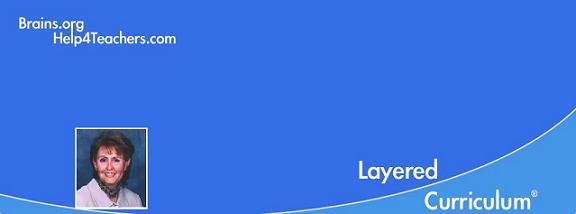__________Layered Curriculum®. . . because every child deserves a special education™_
 |
|
![]() _
_ ![]()
Layered
Curriculum TEXT & WORKBOOK
Set
for only
$43.95
(free shipping in
US)
Tweet
Why Hands-on Tasks are GoodBy Dr. Kathie F. Nunley
Tactile, or 'hands-on', activities benefit everyone and should be plentiful and encouraged with all students. The reason for this relates to the two different memory systems in our heads. One is called the semantic memory and the other is the episodic memory. They are actually in two different locations in the brain.
Semantic memory is composed of those things we have specifically set out to learn and remember, such as "who was the 1st president of the United States?" or "how many stars are there on the flag?" Or, "what is 6 times 3?" All of us were taught the answers to these questions and we intentionally set out to remember them. We stored them in our semantic memory.
But if I ask you "what did you have to eat last night?" or "where were you last Christmas?" Or "what is your most memorable birthday?" You would also be able to answer these questions. But why? Did you specifically set out to remember what you had for dinner last night in anticipation that I would ask you today? Did you go to bed repeating it over and over? No of course not, yet you remember it easily. This is information that is stored in your episodic memory (think of it as the 'episodes' of your life). It is our autobiography of everything that has happened to us. It is unintentionally remembered.
These two systems are linked or networked together and often one will help us with the other. We know that they are completely separate in the brain however, because in some instances a person will lose one but not the other. In Alzheimer's disease, people tend to lose their episodic memory but not their semantic. So although they don't know if they have children, they do remember that there are 50 stars on the flag.
When I tell people I'm a biology teacher they usually reply..."Ughhh, all I remember about biology is that we had to dissect frogs". I find it fascinating that I get this response from so many people, even if it's been 40 years since they were in high school. Why do they remember the frogs? Possibly because it was one of the few hands-on events that they experienced that year.
It is by understanding the relationship between these two memory systems that we can see the true advantage to using "hands-on" activities in the classroom. They target both memory systems and the students have a better chance for retention.
About the Author:
Dr Kathie Nunley is an educational psychologist, researcher and author of several books on parenting and teaching, including A Student's Brain (Brains.org) and the best selling, "Differentiating the High School Classroom" (Corwin Press). She is the developer of the Layered Curriculum® method of instruction and has worked with parents and educators around the world to better structure schools to make brain-friendly environments. In addition, her work has been used by the Boeing Corporation, Family Circle Magazine, the Washington Post, and ABC television.
Email her: Kathie (at) brains.orgCopyright © 1998 - current year by Kathie F. Nunley.
All Rights Reserved.
Layered
Curriculum is a registered trademark developed by
Dr. Kathie F. Nunley.